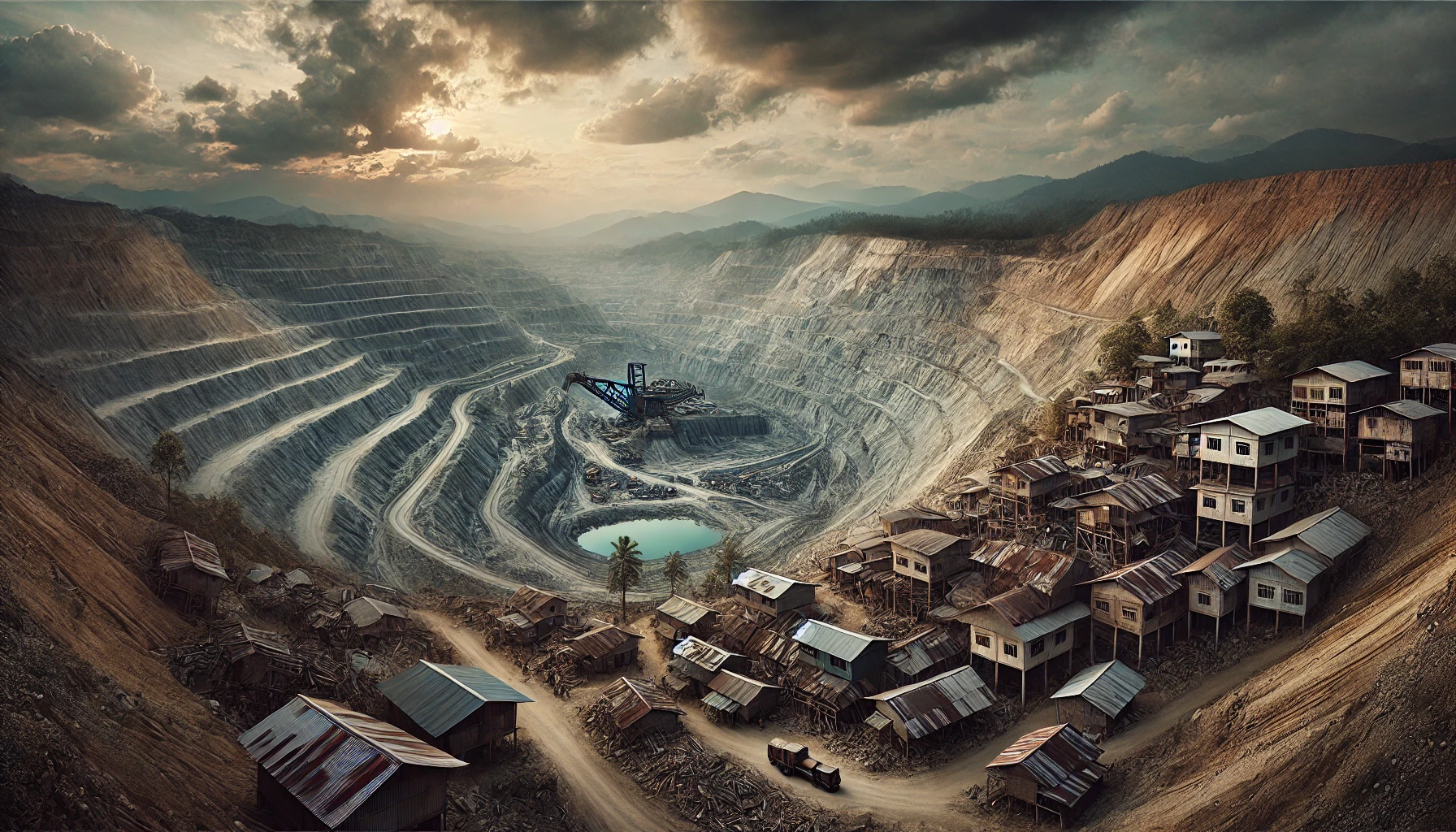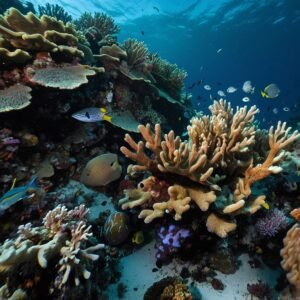
Welcome, fellow earthlings, to a journey into the grimy world of mining! Grab your hard hats and prepare for a wild ride through the pits and perils of this industry that’s been digging up trouble since time immemorial. Today, we’re going to get our hands dirty (metaphorically, of course) and explore the not-so-glamorous side of mining: environmental destruction and community displacement. Buckle up, because this rollercoaster ride through quarries and open pits is about to begin!
Now, before we dive headfirst into this rocky subject, let’s set the stage. Mining has been around since our cave-dwelling ancestors figured out that rocks could be useful for more than just bonking each other on the head. Fast forward a few millennia, and we’ve got ourselves an industry that’s as integral to modern life as coffee is to Monday mornings. But here’s the kicker: while mining gives us the raw materials for everything from smartphones to skyscrapers, it’s also been leaving a trail of environmental devastation and uprooted communities in its wake. Talk about a classic case of “with great power comes great irresponsibility”!
The Environmental Price Tag: Mother Nature’s Least Favorite Bill
Landscape Transformation: When Mountains Become Molehills
Let’s start with the most obvious impact of mining: it turns picturesque landscapes into something that looks like the aftermath of a toddler’s tantrum in a sandbox. Open-pit mining, in particular, is like nature’s equivalent of a bad haircut – it leaves gaping holes in the Earth that can be seen from space. Imagine waking up one day to find that your favorite hiking trail has been replaced by a crater so big it could host the Olympics. That’s the reality for many communities living near mining sites.
But it’s not just about aesthetics. These massive excavations fundamentally alter ecosystems, disrupting wildlife habitats and migration patterns. It’s like playing Jenga with nature – pull out the wrong piece, and the whole thing comes tumbling down. Animals find themselves playing a real-life version of “the floor is lava,” except the lava is actually a toxic pit of mining waste. Not exactly the kind of game show we’d want to watch, right?
Water Woes: When Rivers Run Red (and Not in a Good Way)
Now, let’s talk about water – you know, that stuff that’s essential for life as we know it. Mining has a knack for turning crystal-clear streams into something that looks like it belongs in a horror movie. Acid mine drainage, heavy metal contamination, and sediment pollution are just a few of the charming gifts mining leaves in our waterways. It’s like the industry decided to play mixologist with Mother Nature’s cocktails, and the results are about as appetizing as a mud smoothie.
The consequences of water pollution from mining are far-reaching and long-lasting. Aquatic ecosystems suffer, local water supplies become undrinkable, and agriculture in the area takes a hit. It’s a domino effect that would be impressive if it weren’t so terrifying. And the kicker? Some of these impacts can last for centuries. Talk about leaving a legacy – just not the kind you’d want written on your tombstone.
Air Quality: Breathing in the Not-So-Fresh Stuff
If you thought mining only messed with land and water, think again! The air doesn’t get off scot-free in this environmental onslaught. Mining operations release a cocktail of pollutants into the atmosphere, including dust, heavy metals, and greenhouse gases. It’s like the industry decided to create its own version of smog – let’s call it “smining.”
The health impacts of this airborne assault are no laughing matter. Respiratory issues, cardiovascular problems, and even neurological disorders have been linked to air pollution from mining. It’s as if the industry is running a twisted loyalty program: “Mine here often? Collect points towards your next hospital visit!” Not exactly the kind of rewards system we’d sign up for.
Community Displacement: When “Home Sweet Home” Becomes “Home, Switched Home”
The Great Uprooting: Communities on the Move
Now that we’ve painted a lovely picture of environmental devastation, let’s turn our attention to the human cost of mining. Community displacement is like a forced game of musical chairs, except when the music stops, entire villages find themselves without a seat – or a home.
Mining companies, in their quest for mineral riches, often require vast tracts of land. And guess what? That land is usually occupied by people who’ve been living there for generations. So begins a process that’s about as pleasant as a root canal without anesthesia. Families are forced to relocate, often with inadequate compensation and little say in where they end up. It’s like a twisted version of “House Hunters” where the only options are “take it or leave it.”
The impacts of this displacement go far beyond just losing a physical home. Communities lose their livelihoods, social networks, and cultural heritage. Imagine being told that your ancestral land, the place where your great-great-grandparents are buried, is about to become a giant hole in the ground. Not exactly the kind of family legacy most people have in mind.
Economic Upheaval: When the Gold Rush Becomes a Bust
Mining proponents often tout the economic benefits of their operations. “Jobs! Progress! Prosperity!” they cry. And sure, mining can bring an economic boom to an area – for a while. But here’s the catch: it’s about as sustainable as a chocolate teapot.
When a mine opens, it often creates a “boom town” effect. Jobs are created, money flows, and everyone’s riding high on the mineral express. But what happens when the mine inevitably closes? The town goes bust faster than you can say “nonrenewable resource.” It’s like throwing a massive party and then leaving the host to clean up the mess – except in this case, the mess includes unemployment, abandoned infrastructure, and a whole lot of environmental damage.
The economic disruption doesn’t just affect those directly employed by the mine. Traditional livelihoods like farming and fishing can be decimated by the environmental impacts we discussed earlier. It’s a classic case of robbing Peter to pay Paul, except in this scenario, Peter ends up broke and Paul skips town with all the cash.
The Numbers Game: Mining’s Impact in Cold, Hard Data
Now, I know what you’re thinking: “This all sounds pretty bad, but do you have any actual numbers to back it up?” Well, dear reader, ask and you shall receive! Let’s dive into some data that’ll make your head spin faster than a drill bit in bedrock.
| Impact Category | Statistic | Year |
|---|---|---|
| Land Use | Global mining activities directly affected 57,277 km² of land | 2020 |
| Water Pollution | Mining activities release approximately 1.8 billion tons of sulfuric acid into the environment annually | 2018 |
| Greenhouse Gas Emissions | Mining sector responsible for 4-7% of global greenhouse gas emissions | 2020 |
| Waste Production | Global mining industry produces approximately 100 billion tons of solid waste annually | 2017 |
| Community Displacement | An estimated 220 million people have been displaced by development projects (including mining) since 1980 | 2020 |
| Biodiversity Loss | 82% of mining and quarrying sites overlap with areas of high biodiversity importance | 2019 |
Yikes! Those numbers are about as pretty as a strip mine at sunset. But wait, there’s more! Let’s break down some of these impacts in a bit more detail.
Land Use: When Earth Gets a Bad Facelift
The amount of land directly affected by mining might seem small in the grand scheme of things, but remember – that’s just the tip of the iceberg. For every hectare of land directly mined, many more are affected by associated infrastructure, waste disposal, and pollution. It’s like saying you only spilled a little bit of coffee on the carpet, but conveniently forgetting to mention that you also knocked over the entire pot in the process.
Moreover, the quality of land degradation matters as much as the quantity. Many mining sites are located in biodiversity hotspots or areas of high ecological importance. It’s as if the industry has a knack for finding the most sensitive ecosystems and saying, “Hey, this looks like a great place to dig a giant hole!”
Water Pollution: A Toxic Cocktail on the Rocks
The 1.8 billion tons of sulfuric acid released annually by mining is enough to make your average supervillain green with envy. This acidic onslaught wreaks havoc on water systems, turning pristine rivers and streams into something that looks like it belongs in a post-apocalyptic movie set. And let’s not forget about heavy metal contamination – and no, we’re not talking about the kind that comes with headbanging and electric guitars.
The long-term impacts of water pollution from mining can persist for decades, even centuries after a mine has closed. It’s the gift that keeps on giving – if by “gift” you mean “ongoing environmental catastrophe.”
Greenhouse Gas Emissions: Mining’s Contribution to the Global Sweat Fest
At 4-7% of global greenhouse gas emissions, the mining sector is punching well above its weight in the climate change arena. It’s like that one friend who always insists on cranking up the thermostat, except in this case, the thermostat is the entire planet.
These emissions come from various sources within the mining process, including energy use, transportation, and the release of methane from coal mines. It’s a multi-pronged assault on our atmosphere that makes other industries look like amateurs in the emissions game.
The Silver Lining? More Like a Slightly Less Tarnished Lining
Now, before you throw your hands up in despair and decide to go live in a cave (assuming it hasn’t been mined), let’s talk about some potential solutions. Because believe it or not, there are ways to make mining less of an environmental and social disaster. They’re not perfect, but hey, neither is that haircut you got in the 90s, and you managed to move past that, right?
Sustainable Mining Practices: Oxymoron or Possibility?
The concept of “sustainable mining” might sound like an oxymoron, right up there with “jumbo shrimp” and “deafening silence.” But hear me out. While we can’t eliminate the environmental impact of mining entirely (unless we figure out how to extract minerals through interpretive dance), we can certainly reduce it.
Some mining companies are starting to implement more environmentally friendly practices. These include:
- Water recycling and treatment systems
- Renewable energy use in mining operations
- Improved waste management techniques
- Land rehabilitation and ecosystem restoration
It’s like putting a Band-Aid on a bullet wound, but hey, it’s a start! And who knows? With enough pressure from the public and stricter regulations, we might see more widespread adoption of these practices. It’s either that or wait for the day when we can mine asteroids instead of our own planet. (Elon Musk, if you’re reading this, get on it!)
Community Engagement: A Novel Concept in the Mining World
Here’s a wild idea: what if mining companies actually talked to the communities affected by their operations? I know, I know, it sounds crazy, but bear with me. Some forward-thinking companies are starting to realize that maybe, just maybe, bulldozing someone’s ancestral land without so much as a “howdy-do” isn’t the best way to make friends and influence people.
Community engagement initiatives can include:
- Consultation with local communities before mining begins
- Fair compensation and resettlement programs
- Local employment and training opportunities
- Investment in community infrastructure and services
It’s not a perfect solution, and there’s still a long way to go. But it’s a step in the right direction – kind of like finally admitting you need glasses after years of squinting at road signs and pretending everything’s fine.
The Role of Government: When the Referee Needs to Step Up Their Game
Now, I know what you’re thinking: “Shouldn’t the government be doing something about all this?” Well, my friend, you’ve hit the nail on the head – or should I say, you’ve struck gold? (Sorry, couldn’t resist a mining pun.)
Governments around the world have a crucial role to play in regulating the mining industry and mitigating its negative impacts. This can include:
- Stricter environmental regulations and enforcement
- Mandatory environmental impact assessments
- Protection of indigenous rights and land
- Promotion of sustainable mining practices
But here’s the kicker: many governments, particularly in developing countries, find themselves caught between a rock and a hard place (pun absolutely intended). On one hand, they need to protect their citizens and environment. On the other hand, mining can be a significant source of revenue and economic development. It’s like trying to referee a boxing match while also being one of the boxers – not exactly a recipe for impartiality.
The Consumer’s Role: Voting with Your Wallet (And Maybe Your Actual Vote, Too)
Now, before you start feeling all helpless and despairing, remember this: you, dear reader, have power too! As consumers, we can influence the mining industry through our choices and actions. Here are a few ways you can flex your consumer muscles:
- Support companies that prioritize sustainable and ethical mining practices
- Reduce consumption of products that rely heavily on mined materials
- Advocate for stricter mining regulations and enforcement
- Support organizations working to protect communities and environments affected by mining
It might not feel like much, but remember: even the mightiest canyon starts with a single drop of water. Or in this case, maybe a single conscientious consumer.
A Rocky Road Ahead
As we reach the end of our journey through the murky world of mining, you might be feeling a bit overwhelmed. After all, we’ve covered everything from environmental devastation to community displacement, sprinkled with a healthy dose of dire statistics and dad jokes. But fear not! While the challenges posed by mining are significant, they’re not insurmountable.
The key takeaway here is that change is possible, but it requires action on multiple fronts. Governments need to step up with stricter regulations and enforcement. Mining companies need to prioritize sustainability and community engagement. And we, as consumers and citizens, need to demand better practices and make informed choices.
So the next time you pick up your shiny new smartphone or admire a gleaming skyscraper, take a moment to think about where those materials came from. And maybe, just maybe, consider how we can build a future where progress doesn’t come at the cost of our planet and its people. After all, there’s only one Earth – unless Elon Musk gets his way, in which case, dibs on the first condo on Mars!
Disclaimer: This blog post is based on data and information available up to 2020. While we strive for accuracy, the mining industry and its impacts are complex and constantly evolving. If you spot any inaccuracies or have updated information, please let us know so we can keep this content as current and correct as possible. Remember, knowledge is power – especially when it comes to understanding and addressing the impacts of industries like mining!



